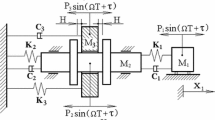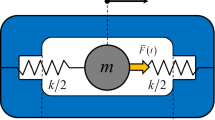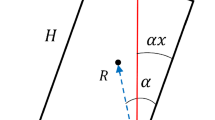Abstract
We focus on the coexistence of strange nonchaotic attractors (SNAs) and a novel mixed attractor in a periodically driven three-degree-of-freedom vibro-impact system with symmetry. SNAs are characterized by the local largest Lyapunov exponent and the phase sensitivity property. The Poincaré map P is the twofold composition of a six-dimensional implicit map Q, implying the symmetry of the vibro-impact system. Since the map Q can capture two conjugate attractors, it is used to investigate the dynamics of the system. With a suitable parameter combination, the Poincaré map P of the vibro-impact system exhibits Neimark–Sacker–pitchfork (NS-P) bifurcation. It is shown that dense phase-locking regions exist in a small parameter interval near this NS-P bifurcation point. Three types of attractors alternate in this small interval: two conjugate phase-locked periodic attractors, two conjugate SNAs and a special type of mixed attractor. As the force frequency \(\omega \) is increased gradually, many phase-locking regions disappear, and the coexistence of two conjugate SNAs takes place instead, which is accompanied by a quick decrease in the width of phase-locking. If two conjugate strange nonchaotic limit sets are suddenly embedded in a chaotic one, a special mixed attractor is caused by a new intermittency accompanied by symmetry restoring bifurcation. This symmetry restoring bifurcation is the result of the collision between two conjugate strange nonchaotic limit sets and a symmetric limit set.









Similar content being viewed by others
References
Grebogi, C., Ott, E., Pelikan, S., Yorke, J.A.: Strange attractors that are not chaotic. Phys. D 13, 261–268 (1984)
Yalcinkaya, T., Lai, Y.-C.: Blowout bifurcation route to strange nonchaotic attractors. Phys. Rev. Lett. 77, 5039–5042 (1996)
Prasad, A., Ramaswamy, R., Satija, I.I., Shah, N.: Collision and symmetry breaking in the transition to strange nonchaotic attractors. Phys. Rev. Lett. 83, 4530–4533 (1999)
Kuznetsov, S.P., Neumann, E., Pikovsky, A., Sataev, I.R.: Critical point of tori-collision in quasiperiodically forced systems. Phys. Rev. E 62, 1995–2007 (2000)
Nishikawa, T., Kaneko, K.: Fractal properties of a torus as a strange nonchaotic attractor. Phys. Rev. E 54, 6114–6124 (1996)
Hunt, B.R., Ott, E.: Fractal properties of robust strange nonchaotic attractors. Phys. Rev. Lett. 87, 254101 (2001)
Kim, J.W., Kim, S.-Y., Hunt, B., Ott, E.: Fractal properties of robust strange nonchaotic attractors in maps of two or more dimensions. Phys. Rev. E 67(3), 036211 (2003)
Datta, S., Ramaswamy, R., Prasad, A.: Fractalization route to strange nonchaotic dynamics. Phys. Rev. E 70, 046203 (2004)
Prasad, A., Mehra, V., Ramaswamy, R.: Intermittency route to strange nonchaotic attractors. Phys. Rev. Lett. 79, 4127–4130 (1997)
Venkatesan, A., Lakshmanan, M., Prasad, A., Ramaswamy, R.: Intermittency transitions to strange nonchaotic attractors in a quasiperiodically driven Duffing oscillator. Phys. Rev. E 61, 3641–3651 (2000)
Kim, S.Y., Lim, W., Ott, E.: Mechanism for the intermittent route to strange nonchaotic attractors. Phys. Rev. E 67, 056203 (2003)
Venkatesan, A., Murali, K., Lakshmanan, M.: Birth of strange nonchaotic attractors through type III intermittency. Phys. Lett. A 259, 246–253 (1999)
Osinga, H.M., Feudel, U.: Boundary crisis in quasiperiodically forced systems. Phys. D 141, 54–64 (2000)
Kim, S.-Y., Lim, W.: Mechanism for boundary crises in quasiperiodically forced period-doubling systems. Phys. Lett. A 334, 160–168 (2005)
Witt, A., Feudel, U., Pikovsky, A.S.: Birth of strange nonchaotic attractors due to interior crisis. Phys. D 109, 180–190 (1997)
Lim, W., Kim, S.-Y.: Interior crises in quasiperiodically forced period-doubling systems. Phys. Lett. A 355, 331–336 (2006)
Lim, W., Kim, S.-Y.: Dynamical mechanism for band-merging transitions in quasiperiodically forced systems. Phys. Lett. A 335, 383–393 (2005)
Senthilkumar, D.V., Srinivasan, K., Thamilmaran, K., Lakshmanan, M.: Bubbling route to strange nonchaotic attractor in a nonlinear series LCR circuit with a nonsinusoidal force. Phys. Rev. E 78, 066211 (2008)
Suresh, K., Prasad, A., Thamilmaran, K.: Birth of strange nonchaotic attractors through formation and merging of bubbles in a quasiperiodically forced Chua’s oscillator. Phys. Lett. A 377, 612–621 (2013)
Feudel, U., Kurths, J., Pikovsky, A.S.: Strange non-chaotic attractor in a quasi-periodically forced circle map. Phys. D 8, 176–186 (1995)
Feudel, U., Grebogi, G., Ott, E.: Phase-locking in quasiperiodically forced systems. Phys. Rep. 290, 11–25 (1997)
Anishchenko, V.S., Vadivasova, T.E., Sosnovtseva, O.: Strange nonchaotic attractors in antonomous and periodically driven systems. Phys. Rev. E 54, 3231–3234 (1996)
Pikovsky, A.S., Feudel, U.: Comment on “strange nonchaotic attractors in antonomous and periodically driven systems”. Phys. Rev. E 6(56), 7320–7321 (1997)
Zhang, Y.X., Luo, G.W.: Torus-doubling bifurcations and strange nonchaotic attractors in a vibro-impact system. J. Sound Vib. 332, 5462–5475 (2013)
Chossat, P., Golubitsky, M.: Symmetry-increasing bifurcation of chaotic attractors. Phys. D 32, 423–436 (1988)
Grebogi, C., Ott, E., Romeiras, F., Yorke, J.A.: Critical exponents for crisis-induced intermittency. Phys. Rev. A 11(36), 5366–5380 (1987)
Grebogi, C., Ott, E., Yorke, J.A.: Chaotic attractors in crisis. Phys. Rev. Lett. 48, 1507–1510 (1982)
Grebogi, C., Ott, E., Yorke, J.A.: Crisis, sudden changes in chaotic attractors and transient chaos. Phys. D 7, 181–200 (1983)
Ben-Tal, A.: Symmetry restoration in a class of forced oscillators. Phys. D 171, 236–248 (2002)
Holmes, P.J.: The dynamics of repeated impacts with a sinusoidally vibrating table. J. Sound Vib. 84(2), 173–189 (1982)
Shaw, S.W.: Forced vibrations of a beam with one-sided amplitude constraint: theory and experiment. J. Sound Vib. 92(2), 199–212 (1985)
Whiston, G.S.: Global dynamics of a vibro-impacting linear oscillator. J. Sound Vib. 115(2), 303–319 (1987)
Luo, A.C.J.: Period-doubling induced chaotic motion in the LR model of a horizontal impact oscillator. Chaos Solitons Fractals 19, 823–839 (2004)
Luo, G.W., Xie, J.H.: Hopf bifurcation and chaos of a two-degree-of-freedom vibro-impact system in two strong resonance cases. Int. J. Non Linear Mech. 37(1), 19–34 (2002)
Xie, J.H., Ding, W.C.: Hopf-Hopf bifurcation and invariant torus \(T^{2}\) of a vibro-impact system. Int. J. Non Linear Mech. 40, 531–543 (2005)
Ding, W.C., Xie, J.H., Sun, Q.G.: Interaction of Hopf and period-doubling bifurcations of a vibro-impact system. J. Sound Vib. 275, 27–45 (2004)
Yue, Y., Xie, J.H.: Neimark-Sacker-pitchfork bifurcation of the symmetric period fixed point of the Poincaré map in a three-degree-of-freedom vibro-impact system. Int. J. Non Linear Mech. 48, 51–58 (2013)
Nordmark, A.B.: Non-periodic motion caused by grazing incidence in an impact oscillator. J. Sound Vib. 145(2), 279–297 (1991)
Mehran, K., Zahawi, B., Giaouris, D.: Investigation of the near-grazing behavior in hard-impact oscillators using model-based TS fuzzy approach. Nonlinear Dyn. 69, 1293–1309 (2012)
Kundu, S., Banerjee, S., Ing, J., Pavlovskaia, E., Wiercigroch, M.: Singularities in soft-impacting systems. Phys. D 241, 553–565 (2012)
Ma, Y., Ing, J., Banerjee, S., Wiercigroch, M., Pavlovskaia, E.: The nature of the normal form map for soft impacting systems. Int. J. Non Linear Mech. 43, 504–513 (2008)
Chillingworth, D.R.J.: Dynamics of an impacting oscillator near a degenerate graze. Nonlinearity 23, 2723–2748 (2010)
Zhao, X., Dankowicz, H.: Unfolding degenerate grazing dynamics in impact actuators. Nonlinearity 19, 399–418 (2006)
Thota, P., Dankowicz, H.: Analysis of grazing bifurcations of quasiperiodic system attractors. Phys. D 220, 163–174 (2006)
Kryzhevich, S., Wiercigroch, M.: Topology of vibro-impact systems in the neighborhood of grazing. Phys. D 241, 1919–1931 (2012)
Du, Z.D., Li, Y.R., Shen, J., Zhang, W.N.: Impact oscillators with homoclinic orbit tangent to the wall. Phys. D 245, 19–33 (2013)
O’Connor, D., Luo, A.C.J.: On discontinuous dynamics of a freight train suspension system. Int. J. Bifurcat. Chaos 12(24), 1450163 (2014)
Gan, C.B., Lei, H.: Stochastic dynamic analysis of a kind of vibro-impact system under multiple harmonic and random excitations. J. Sound Vib. 330, 2174–2184 (2011)
Zhai, H.M., Ding, Q.: Stability and nonlinear dynamics of a vibration system with oblique collisions. J. Sound Vib. 332, 3015–3031 (2013)
Xu, H.D., Wen, G.L., Qin, Q.X., Zhou, H.A.: New explicit critical criterion of Hopf-Hopf bifurcation in a general discrete time system. Commun. Nolinear Sci. Numer. Simul. 18, 2120–2128 (2013)
Feng, J.Q., Xu, W.: Grazing-induced chaostic crisis for periodic orbits in vibro-impact systems. Chin. J. Theor. Appl. Mech. 45(1), 30–36 (2013)
Gendelman, O.V.: Analytic treatment of a system with a vibro-impact nonlinear energy sink. J. Sound Vib. 331(21), 4599–4608 (2012)
Gendelman, O.V., Alloni, A.: Dynamics of forced system with vibro-impact energy sink. J. Sound Vib. 358(8), 301–314 (2015)
Brake, M.R.: The effect of the contact model on the impact-vibration response of continuous and discrete systems. J. Sound Vib. 332, 3849–3878 (2013)
Wagg, D.J.: Multiple non-smooth events in multi-degree-of-freedom vibro-impact systems. Nonlinear Dyn. 43(1–2), 137–148 (2006)
Nordmark, A.B., Piiroinen, P.T.: Simulation and stability analysis of impacting systems with complete chattering. Nonlinear Dyn. 58(1–2), 85–106 (2009)
Luo, G.W., Shi, Y.Q., Jiang, C.X., Zhao, L.Y.: Diversity evolution and parameter matching of periodic-impact motions of a periodically forced system with a clearance. Nonlinear Dyn. 78, 2577–2604 (2014)
Zhang, H.G., Zhang, Y.X., Luo, G.W.: Basin of coexisting multi-dimensional tori in a vibro-impact system. Nonlinear Dyn. 79, 2177–2185 (2015)
Yue, X.L., Xu, W., Wang, L.: Global analysis of boundary and interior crises in an elastic impact oscillator. Commun. Nolinear Sci. Numer. Simul. 18, 3567–3574 (2013)
Yue, Y., Xie, J.H.: Capturing the symmetry of attractors and the transition to symmetric chaos in a vibro-impact system. Int. J. Bifurcat. Chaos 5(22), 1250109 (2012)
Yue, Y., Xie, J.H.: Lyapunov exponents and coexistense of attractors in vibro-impact systems with symmetric two-sided constraints. Phys. Lett. A 373, 2041–2046 (2009)
Yang, G.D., Xu, W., Gu, X.D., Huang, D.M.: Response analysis for a vibroimpact Duffing system with bilateral barriers under external and parametric Gaussian white noises. Chaos Solitons Fractals 87, 125–135 (2016)
Thomsen, J.J.: Vibrations and Stability: Advanced Theory, Analysis and Tools. Springer, Berlin (2003)
Pikovsky, A.S., Feudel, U.: Characterizing strange nonchaotic attractors. Chaos 5, 253–260 (1995)
Eckmann, J.-P., Ruelle, D.: Ergodic theory of chaos and strange attractors. Rev. Mod. Phys. 57, 617–656 (1985)
Grassberger, P., Baddii, R., Politi, A.: Scaling laws for invariant measures on hyperbolic and nonhyperbolic attractors. J. Stat. Phys. 51, 135–178 (1988)
Abarbanel, H.D.I., Brown, R., Kennel, M.B.: Variation of Lyapunov exponents on a strange attractor. J. Nonlinear Sci. 1, 175–199 (1991)
Abarbanel, H.D.I., Brown, R., Kennel, M.B.: Local Lyapunov exponents computed from observed data. J. Nonlinear Sci. 2, 343–365 (1992)
Wang, X., Zhan, M., Lai, C.H., Lai, Y.C.: Strange nonchaotic attractors in random dynamical systems. Phys. Rev. Lett. 92, 074102 (2004)
Prasad, A., Ramaswamy, R.: Characteristic distributions of finite-time Lyapunov exponents. Phys. Rev. E 60(3), 2761–2766 (1999)
Kapitaniak, T.: Generating strange nonchaotic trajectories. Phys. Rev. E 47(2), 1408–1410 (1993)
Pikovsky, A.S., Feudel, U.: Correlations and spectra of strange nonchaotic attractors. J. Phys. A 27, 5209–5219 (1994)
Yalcinkaya, T., Lai, Y.C.: Bifurcation to strange nonchaotic attractors. Phys. Rev. E 56, 1623–1630 (1997)
Ding, M., Grebogi, C., Ott, E.: Dimensions of strange nonchaotic attractors. Phys. Lett. A 137, 167–172 (1989)
Manffra, E.F., Caldas, I.L., Viana, R.L., Kalinowski, H.J.: Type-I intermittency and crisis-induced intermittency in a semiconductor laser under injection current modulation. Nonlinear Dyn. 27, 185–195 (2002)
Werner, J.P., Stemler, T., Benner, H.: Crisis and stochastic resonance in Shinrili’s circuit. Phys. D 237, 859–865 (2008)
Chian, A.C.-L., Rempel, E.L., Rogers, C.: Complex economic dynamics: chaotic saddle, crisis and intermittency. Chaos Solitons Fractals 29, 1194–1218 (2006)
Tchistiakov, V.: Detecting symmetry breaking bifurcations in the system describing the dynamics of coupled arrays of Josephson junctions. Phys. D 91, 67–85 (1996)
Acknowledgments
This work is supported by National Natural Science Foundation of China (11272268, 11572263) and Scholarship of China.
Author information
Authors and Affiliations
Corresponding author
Appendices
Appendix 1: Expressions of the integration constants \(a_i\) and \(b_i\) as the function of the initial conditions
Let the coordinates of the initial map point \(\mathbf{X}_0 \in {\varvec{\Pi }} _1 \) be \((x_{10} ,x_{20} ,y_{10} ,y_{20} ,y_{30} ,\tau _0 )\). Substituting \(t=0\) into the general solutions shown in Eq. (8), we obtain
and
Besides, since \(x_2^*-x_3^*=h\) with \(t=0\), the following relation holds:
(44), (45) and (46) generate six equations about six unknowns \(a_i \) and \(b_i \) (\(i=1, 2, 3\)). Then the integration constants \(a_i \) and \(b_i \) can be expressed as the following functions depending on the initial conditions \((x_{10} ,x_{20} ,y_{10} ,y_{20} ,y_{30} ,\tau _0 )\):
where \(\alpha _{ji} (j=1,\ldots ,5)\) and \(\beta _{ki} (k=1,\ldots ,8)\) are constants determined by system parameters.
If the initial conditions \((x_{10} ,x_{20} ,y_{10} ,y_{20} ,y_{30} ,\tau _0 )\) are replaced by \((x_1 (n),x_2 (n),y_1 (n),y_2 (n),y_3 (n),\tau (n))\), Eq. (13) is obtained.
Then we obtain the partial derivatives of the integration constants about the initial conditions \((x_{10},x_{20},y_{10},y_{20},y_{30},\tau _0)\):
Appendix 2: Expressions of Jacobi matrix
We replace the initial conditions \((x_1 (n),x_2 (n),y_1 (n),y_2 (n),y_3 (n),\tau (n))\) by \((x_{10} ,x_{20} ,y_{10} ,y_{20} ,y_{30} ,\tau _0 )\), Eq. (14) is rewritten as:
According to the implicit function theorem, we obtain
Let the Jacobi matrix \(\mathbf{J}_\mathbf{Q} (\mathbf{X}_0 )=[J_{ij} ]_{6\times 6} \). According to the expression shown in Eq. (12), \(a_{ij}\) can be computed as follows by the chain rule:
where \(\frac{\partial a_i }{\partial x_{10} }\), \(\frac{\partial a_i }{\partial x_{20} }\), \(\frac{\partial a_i }{\partial y_{10} }\), \(\frac{\partial a_i }{\partial y_{20} }\), \(\frac{\partial a_i }{y_{30} }\), \(\frac{\partial a_i }{\tau _0 }\),\(\frac{\partial b_i }{\partial x_{10} }\), \(\frac{\partial b_i }{\partial x_{20} }\), \(\frac{\partial b_i }{\partial y_{10} }\), \(\frac{\partial b_i }{\partial y_{20} }\), \(\frac{\partial b_i }{\partial y_{30} }\), \(\frac{\partial b_i }{\tau _0 }\) are shown as Eq. (44).
Appendix 3: Analytic solutions of symmetric fixed point
Let the coordinates of the symmetric fixed point X \(^{*}\) be \((x_1^*,x_2^*,y_1^*,y_2^*,y_3^*,\tau ^{*})\). For both stable and unstable cases, the coordinates of the symmetric fixed point X \(^{*}\) can be determined analytically by \(\mathbf{X}^{*}=\mathbf{Q}(\mathbf{X}^{*})\). Since \(\mathbf{Q}=\mathbf{R}^{-1}\circ \mathbf{Q}_u \), \(\mathbf{X}^{*}=\mathbf{Q}(\mathbf{X}^{*})\) means \(\mathbf{RX}^{*}=\mathbf{Q}_u (\mathbf{X}^{*})\), which implies that after \(M_3 \) impacts the right and the left stops, the associated state coordinates of map point are equal in absolute value and opposite in direction.
Let the initial time be \(t_0 =0\) after impacting at the left stop, and inserting it to Eq. (8), we obtain the coordinates \(x_i (t_0 )\) and \(y_i (t_0 )=\dot{x}_i (t_0 )(i=1,2,3)\) after impacting at the left stop. Then let the time be \(t_1 =\frac{n\pi }{\omega }\) (i.e., half of n excitation periods) where n is an odd integer, and inserting it into Eq. (8), we obtain the coordinates \(x_i (t_1 )\) and \(y_i (t_1 )=\dot{x}_i (t_1 )(i=1,2,3)\) after impacting at the right stop.
Based on \(\mathbf{RX}^{*}=\mathbf{Q}_u (\mathbf{X}^{*})\), we have
Then we obtain the following seven equations about \(\tau =\tau ^{*}\), \(a_i \) and \(b_i (i=1,2,3)\):
By elimination and simplification, we obtain the following equation about \(\tau ^{*}\):
where u and v are constants determined by the system parameters. Then \(\tau ^{*}\) can be solved as
Subsequently, inserting the expression of \(\tau ^{*}\) into Eq. (49), we obtain expressions of integration constants \(a_i \) and \(b_i \quad (i=1,2,3)\). Inserting the value of \(a_i \), \(b_i \) and \(\tau ^{*}\) into Eq. (8), and letting the time \(t=0\), we obtain the coordinates \((x_1^*,x_2^*,y_1^*,y_2^*,y_3^*,\tau ^{*})\) of the symmetric fixed point X \(^{*}\).
Rights and permissions
About this article
Cite this article
Yue, Y., Miao, P. & Xie, J. Coexistence of strange nonchaotic attractors and a special mixed attractor caused by a new intermittency in a periodically driven vibro-impact system. Nonlinear Dyn 87, 1187–1207 (2017). https://doi.org/10.1007/s11071-016-3109-2
Received:
Accepted:
Published:
Issue Date:
DOI: https://doi.org/10.1007/s11071-016-3109-2




